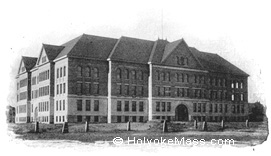eight miles to attend town meetings or religions service, neither of which duties, as the family names would seem to indicate, would be much neglected. When first set off, West Springfield was said to be sixteen miles long from north to south, and about four miles wide from east to west, embracing the territory of Holyoke, West Springfield, Agawam and Feeding Hills, the centre of which was West Springfield proper. This northerly section did not grow rapidly. The "fields," now occupied by the city proper, was a sandy, unproductive section; but improved farming and the demands of distant markets gradually brought under profitable cultivation all of the lands lying along Northampton street, even covering with heavy crops the huge foot-hills of the Mt. Tom range. Much corn, some wheat and a large harvest of rye were taken to the Boston and other markets every year from this section, many farmers vying with one another in the amount of their product, Elisha Ashley and Deacon Peresh Hitchcock having raised one year, the one 1,300 bushels of rye and the other 1,400 bushels. The reader will not be startled to learn that this product was used in the manufacture of whiskey, or that ultimately a distillery was started at "Money Hole Hill" and others at places down the valley. Rye was then worth $1 and upwards a bushel.
As the social status of New England was based upon the church and the school, it is of interest to learn that both came to the new settlement as soon as the problem of living had been
© Laurel O'Donnell 1998 - 2006, all rights reserved
This document is an edited adaptation of the original publication and may be downloaded for personal non-commercial use only. These pages should not be reproduced or distributed in any format without permission. |


